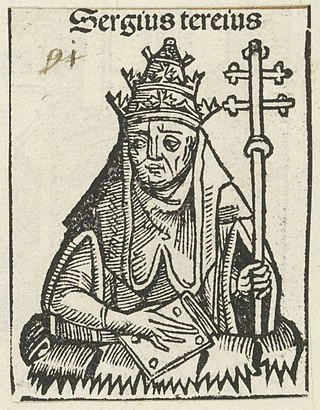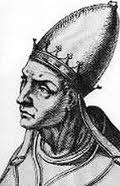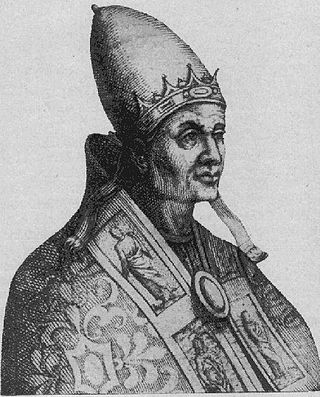
Pope Agapetus II was the bishop of Rome and ruler of the Papal States from 10 May 946 to his death. A nominee of the princeps of Rome, Alberic II of Spoleto, his pontificate occurred during the period known as the Saeculum obscurum.
Pope Honorius II, born Lamberto Scannabecchi, was head of the Catholic Church and ruler of the Papal States from 21 December 1124 to his death in 1130.
Pope Benedict VI was the bishop of Rome and ruler of the Papal States from 19 January 973 to his death in 974. His brief pontificate occurred in the political context of the establishment of the Holy Roman Empire, during the transition between the reigns of Otto I and Otto II, incorporating the struggle for power of Roman aristocratic families such as the Crescentii.
Pope Benedict VIII was bishop of Rome and ruler of the Papal States from 18 May 1012 until his death. He was born Theophylact to the noble family of the counts of Tusculum. Unusually for a medieval pope, he had strong authority both in Rome and abroad.
Pope Gregory II was the bishop of Rome from 19 May 715 to his death. His defiance of Emperor Leo III the Isaurian as a result of the iconoclastic controversy in the Eastern Empire prepared the way for a long series of revolts, schisms, and civil wars that eventually led to the establishment of the temporal power of the popes.

Pope Gregory IV was the bishop of Rome and ruler of the Papal States from October 827 to his death. His pontificate was notable for the papacy’s attempts to intervene in the quarrels between Emperor Louis the Pious and his sons. It also saw the breakup of the Carolingian Empire in 843.
Pope Stephen IV was the bishop of Rome and ruler of the Papal States from June 816 to his death. Stephen belonged to a noble Roman family. In October 816, he crowned Louis the Pious as emperor at Reims, and persuaded him to release some Roman political prisoners he held in custody. He returned to Rome, by way of Ravenna, sometime in November and died the following January.
Pope Stephen VIII was the bishop of Rome and nominal ruler of the Papal States from 14 July 939 to his death. His pontificate occurred during the Saeculum obscurum, when the power of popes was diminished by the ambitious counts of Tusculum, and was marked by the conflict between his patron, Alberic II of Spoleto, and King Hugh of Italy.
Pope Stephen IX was the Bishop of Rome and ruler of the Papal States from 3 August 1057 to his death in 29 March 1058. He was a member of the Ardenne-Verdun family, who ruled the Duchy of Lorraine, and started his ecclesiastical career as a canon in Liège. He was invited to Rome by Pope Leo IX, who made him chancellor in 1051 and one of three legates to Constantinople in 1054. The failure of their negotiations with Patriarch Michael I Cerularius of Constantinople and Archbishop Leo of Ohrid led to the permanent East–West Schism. He continued as chancellor to the next pope, Victor II, and was elected abbot of the Benedictine monastery of Montecassino.

Pope Sergius III was the bishop of Rome and nominal ruler of the Papal States from 29 January 904 to his death. He was pope during a period of violence and disorder in central Italy, when warring aristocratic factions sought to use the material and military resources of the papacy. At the behest of Theophylact I of Tusculum, Sergius seized the papal throne from Antipope Christopher, who in turn had deposed Pope Leo V. Sergius' reign was subsequently marked by Theophylact's influence. As pope, Sergius continued many ecclesiastical controversies of his predecessors, including conflict over Pope Formosus' legacy, annulling all ordinations made by the late pope, and the filioque controversy with eastern patriarchs. His pontificate was similarly marked by temporal conflicts, with Sergius' refusal to crown Berengar I of Italy as Holy Roman Emperor, and his support of Byzantine Emperor Leo VI the Wise's fourth marriage. Sergius also saw the restoration of the Lateran Palace.

Pope Leo VIII was a Roman prelate who claimed the Holy See from 963 until 964 in opposition to John XII and Benedict V and again from 23 June 964 to his death. Today, he is considered by the Catholic Church to have been an antipope during the first period and the legitimate Pope during the second. An appointee of Holy Roman Emperor Otto I, Leo VIII's pontificate occurred after the period known as the saeculum obscurum.
Pope Damasus II was the Bishop of Rome and ruler of the Papal States from 17 July 1048 to his death on 9 August that same year. He was the second of the German pontiffs nominated by Emperor Henry III. A native of Bavaria, he was the third German to become pope and had one of the shortest papal reigns.
Pope John XIII was the bishop of Rome and ruler of the Papal States from 1 October 965 to his death. His pontificate was caught up in the continuing conflict between the Holy Roman emperor, Otto I, and the Roman nobility. After long and arduous negotiations, he succeeded in arranging a Byzantine marriage for Otto II, in an effort to legitimize the Ottonian claim to imperial dignity. He also established church hierarchy in Poland and Bohemia.

Pope John XII, born Octavian, was the bishop of Rome and ruler of the Papal States from 16 December 955 to his death in 964. He was related to the counts of Tusculum, a powerful Roman family which had dominated papal politics for over half a century. He became pope in his late teenage years or early twenties. In 960, he clashed with the Lombards to the south. Unable to control Rome easily, he sought help from King Otto I of Germany and crowned him emperor. John XII's pontificate became infamous for the alleged depravity and worldliness with which he conducted his office. He soon fell out with Otto, but died before Otto could succeed in his attempt to depose him.
Adaldag was the seventh archbishop of Hamburg-Bremen, from 937 until his death.

The Tusculan Papacy was a period of papal history from 1012 to 1048 where three successive relatives of the counts of Tusculum were installed as pope.
The Synods of Rome in 731 were two synods held in St. Peter’s Basilica in the year 731 under the authority of Pope Gregory III to defend the practice of Icon veneration.
The Synod of Rome (963) was a possibly uncanonical synod held in St. Peter's Basilica from 6 November until 4 December 963, under the authority of the Holy Roman Emperor, Otto I to depose Pope John XII. The events of the synod were recorded by Liutprand of Cremona.
The Synod of Rome (964) was a synod held in St. Peter’s Basilica from 26 to 28 February 964, for the purpose of condemning the Synod of Rome (963) and to depose Pope Leo VIII.
The Lateran Council (964) was a synod held in the Lateran Palace on 23 June 964, for the purpose of deposing Pope Benedict V.






